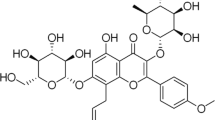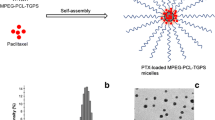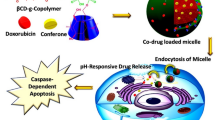ABSTRACT
Purpose
Resistance to gemcitabine in pancreatic cancer (PC) may account for the failure of conventional treatments. Recently, salinomycin (SAL) has been identified as selective inhibitor of cancer stem cells (CSCs). In our study, we aimed to deliver SAL to gemcitabine-resistant PC by the aid of poly ethylene glycol-b-poly lactic acid (PEG-b-PLA) polymeric micelles (PMs).
Methods
SAL-loaded PMs were prepared and investigated in terms of pharmaceutical properties. MTT and Annexin V/PI assays were used to study cell proliferation and apoptosis in AsPC-1 cells in response to treatment with SAL micellar formulations. Alterations in CSC phenotype, invasion strength, and mRNA expression of epithelial mesenchymal transition (EMT) markers were also determined in the treated cells. In vivo antitumor study was performed in Balb/c AsPC-1 xenograft mice.
Results
PM formulations of SAL were prepared in suitable size and loading traits. In gemcitabine-resistant AsPC-1 cells, SAL was found to significantly increase cell mortality and apoptosis. It was also observed that SAL micellar formulations inhibited invasion and harnessed EMT in spite of induced expression of Snail. The in vivo antitumor experiment showed significant tumor eradication and the highest survival probability in mice treated with SAL PMs.
Conclusions
The obtained results showed the efficacy of SAL nano-formulation against PC tumor cells.





Similar content being viewed by others
Abbreviations
- CMC:
-
Critical micelle concentration
- CSCs:
-
Cancer stem cells
- DLS:
-
Dynamic light scattering
- EE:
-
Entrapment efficiency
- EMT:
-
Epithelial to mesenchymal transition
- EPR:
-
Enhanced permeability and retention
- FBS:
-
Fetal bovine serum
- HPLC:
-
High performance liquid chromatography
- IC50% :
-
50% inhibitory concentration
- LD:
-
Loading density
- MTT:
-
3-(4,5-dimethylthiazolyl-2)-2,5-diphenyl tetrazolium bromide
- NP:
-
Nanoparticle
- PBS:
-
Phosphate buffered saline
- PC:
-
Pancreatic cancer
- PDI:
-
Polydispersity index
- PEG-b-PLA:
-
Poly ethylene glycol-b-poly lactic acid
- PI:
-
Propidium iodide
- PMs:
-
Polymeric micelles
- RT-PCR:
-
Real-time polymerase chain reaction
- SAL:
-
Salinomycin
- TEM:
-
Transmission electron microscopy
- THF:
-
Tetrahydrofuran
REFERENCES
Holly EA, Chaliha I, Bracci PM, Gautam M. Signs and symptoms of pancreatic cancer: a population-based case–control study in the San Francisco Bay area. Clin Gastroenterol Hepatol. 2004;2(6):510–7.
Siegel R, Naishadham D, Jemal A. Cancer statistics, 2012. CA Cancer J Clin. 2012;62(1):10–29.
Heinemann V. Gemcitabine: progress in the treatment of pancreatic cancer. Oncology. 2000;60(1):8–18.
Brusa P, Immordino ML, Rocco F, Cattel L. Antitumor activity and pharmacokinetics of liposomes containing lipophilic gemcitabine prodrugs. Anticancer Res. 2007;27(1A):195–9.
Hung SW, Mody HR, Govindarajan R. Overcoming nucleoside analog chemoresistance of pancreatic cancer: a therapeutic challenge. Cancer Lett. 2012;320(2):138–49.
Shackleton M, Quintana E, Fearon ER, Morrison SJ. Heterogeneity in cancer: cancer stem cells versus clonal evolution. Cell. 2009;138(5):822–9.
Li Y, Kong D, Ahmad A, Bao B, Sarkar FH. Pancreatic cancer stem cells: emerging target for designing novel therapy. Cancer Lett. 2013;338(1):94–100.
Javle M, Gibbs J, Iwata K, Pak Y, Rutledge P, Yu J, et al. Epithelial-mesenchymal transition (EMT) and activated extracellular signal-regulated kinase (p-Erk) in surgically resected pancreatic cancer. Ann Surg Oncol. 2007;14(12):3527–33.
Singh A, Settleman J. EMT, cancer stem cells and drug resistance: an emerging axis of evil in the war on cancer. Oncogene. 2010;29(34):4741–51.
Gupta PB, Onder TT, Jiang G, Tao K, Kuperwasser C, Weinberg RA, et al. Identification of selective inhibitors of cancer stem cells by high-throughput screening. Cell. 2009;138(4):645–59.
Naujokat C, Steinhart R. Salinomycin as a drug for targeting human cancer stem cells. BioMed Res. Int. 2012;2012.
Zhang G-N, Liang Y, Zhou L-J, Chen S-P, Chen G, Zhang T-P, et al. Combination of salinomycin and gemcitabine eliminates pancreatic cancer cells. Cancer Lett. 2011;313(2):137–44.
Zhao P, Dong S, Bhattacharyya J, Chen M. iTEP nanoparticle-delivered salinomycin displays an enhanced toxicity to cancer stem cells in orthotopic breast tumors. Mol Pharm. 2014;11(8):2703–12.
Torchilin VP. Micellar nanocarriers: pharmaceutical perspectives. Pharm Res. 2007;24(1):1–16.
Lee KS, Chung HC, Im SA, Park YH, Kim CS, Kim S-B, et al. Multicenter phase II trial of Genexol-PM, a Cremophor-free, polymeric micelle formulation of paclitaxel, in patients with metastatic breast cancer. Breast Cancer Res Treat. 2008;108(2):241–50.
Kim SC, Kim DW, Shim YH, Bang JS, Oh HS, Kim SW, et al. In vivo evaluation of polymeric micellar paclitaxel formulation: toxicity and efficacy. J Control Release. 2001;72(1):191–202.
Daman Z, Ostad S, Amini M, Gilani K. Preparation, optimization and< i> in</i>< i> vitro</i> characterization of stearoyl-gemcitabine polymeric micelles: a comparison with its self-assembled nanoparticles. Int J Pharm. 2014;468(1):142–51.
Guglielmo Dusi VG. Liquid chromatography with ultraviolet detection of lasalocid, monensin, salinomycin and narasin in poultry feeds using pre-column derivatization. J Chromatogr A. 1999;835(1–2):243–6.
Pfaffl MW, Horgan GW, Dempfle L. Relative expression software tool (REST) for group-wise comparison and statistical analysis of relative expression results in real-time PCR. Nucleic Acids Res. 2002;30(9):e36. Comparative Study.
Stathis A, Moore MJ. Advanced pancreatic carcinoma: current treatment and future challenges. Nat Rev Clin Oncol. 2010;7(3):163–72.
Arumugam T, Ramachandran V, Fournier KF, Wang H, Marquis L, Abbruzzese JL, et al. Epithelial to mesenchymal transition contributes to drug resistance in pancreatic cancer. Cancer Res. 2009;69(14):5820–8.
National Centre for the Replacement Refinement & Reduction of Animals in Research. Mouse: Decision tree for blood sampling. 2014. Available from: http://www.nc3rs.org.uk/mouse-decision-tree-blood-sampling.
Greish K. Enhanced permeability and retention (EPR) effect for anticancer nanomedicine drug targeting. Cancer Nanotechnology: Springer; 2010. p. 25–37.
Rijcken C, Soga O, Hennink W, Van Nostrum C. Triggered destabilisation of polymeric micelles and vesicles by changing polymers polarity: an attractive tool for drug delivery. J Control Release. 2007;120(3):131–48.
Zhang J, Liu J. Tumor stroma as targets for cancer therapy. Pharmacol Ther. 2013;137(2):200–15.
Vermes I, Haanen C, Steffens-Nakken H, Reutellingsperger C. A novel assay for apoptosis flow cytometric detection of phosphatidylserine expression on early apoptotic cells using fluorescein labelled annexin V. J Immunol Methods. 1995;184(1):39–51.
He L, Wang F, Dai W-Q, Wu D, Lin C-L, Wu S-M, et al. Mechanism of action of salinomycin on growth and migration in pancreatic cancer cell lines. Pancreatology. 2013;13(1):72–8.
Olempska M, Eisenach PA, Ammerpohl O, Ungefroren H, Fandrich F, Kalthoff H. Detection of tumor stem cell markers in pancreatic carcinoma cell lines. Hepatobiliary Pancreat Dis Int. 2007;6(1):92–7.
Dong T-T, Zhou H-M, Wang L-L, Feng B, Lv B, Zheng M-H. Salinomycin selectively targets ‘CD133+’ cell subpopulations and decreases malignant traits in colorectal cancer lines. Ann Surg Oncol. 2011;18(6):1797–804.
Zavadil J, Bitzer M, Liang D, Yang Y-C, Massimi A, Kneitz S, et al. Genetic programs of epithelial cell plasticity directed by transforming growth factor-β. Proc Natl Acad Sci. 2001;98(12):6686–91.
Batlle E, Sancho E, Francí C, Domínguez D, Monfar M, Baulida J, et al. The transcription factor snail is a repressor of E-cadherin gene expression in epithelial tumour cells. Nat Cell Biol. 2000;2(2):84–9.
Eger A, Aigner K, Sonderegger S, Dampier B, Oehler S, Schreiber M, et al. DeltaEF1 is a transcriptional repressor of E-cadherin and regulates epithelial plasticity in breast cancer cells. Oncogene. 2005;24(14):2375–85.
Comijn J, Berx G, Vermassen P, Verschueren K, van Grunsven L, Bruyneel E, et al. The two-handed E box binding zinc finger protein SIP1 downregulates E-cadherin and induces invasion. Mol Cell. 2001;7(6):1267–78.
Bolós V, Peinado H, Pérez-Moreno MA, Fraga MF, Esteller M, Cano A. The transcription factor Slug represses E-cadherin expression and induces epithelial to mesenchymal transitions: a comparison with Snail and E47 repressors. J Cell Sci. 2003;116(3):499–511.
Du Z, Qin R, Wei C, Wang M, Shi C, Tian R, et al. Pancreatic cancer cells resistant to chemoradiotherapy rich in “stem-cell-like” tumor cells. Dig Dis Sci. 2011;56(3):741–50.
Ivaska J, Pallari H-M, Nevo J, Eriksson JE. Novel functions of vimentin in cell adhesion, migration, and signaling. Exp Cell Res. 2007;313(10):2050–62.
Fuyuhiro Y, Yashiro M, Noda S, Kashiwagi S, Matsuoka J, Doi Y, et al. Clinical significance of vimentin-positive gastric cancer cells. Anticancer Res. 2010;30(12):5239–43.
Eckes B, Colucci-Guyon E, Smola H, Nodder S, Babinet C, Krieg T, et al. Impaired wound healing in embryonic and adult mice lacking vimentin. J Cell Sci. 2000;113(13):2455–62.
Bae K-M, Su Z, Frye C, McClellan S, Allan RW, Andrejewski JT, et al. Expression of pluripotent stem cell reprogramming factors by prostate tumor initiating cells. J Urol. 2010;183(5):2045–53.
Kuo SZ, Blair KJ, Rahimy E, Kiang A, Abhold E, Fan J-B, et al. Salinomycin induces cell death and differentiation in head and neck squamous cell carcinoma stem cells despite activation of epithelial-mesenchymal transition and Akt. BMC Cancer. 2012;12(1):556.
Zhang Y, Zhang H, Wang X, Wang J, Zhang X, Zhang Q. The eradication of breast cancer and cancer stem cells using octreotide modified paclitaxel active targeting micelles and salinomycin passive targeting micelles. Biomaterials. 2012;33(2):679–91.
ACKNOWLEDGMENTS AND DISCLOSURES
We would like to express our profound thanks to Dr. Babak Paknejad for his assistance in animal experiments. This work is a part of the PhD project of first author and was financially supported by a grant numbered 91-03-33-19300 from Tehran University of Medical Sciences and Health Services.
Author information
Authors and Affiliations
Corresponding author
Rights and permissions
About this article
Cite this article
Daman, Z., Montazeri, H., Azizi, M. et al. Polymeric Micelles of PEG-PLA Copolymer as a Carrier for Salinomycin Against Gemcitabine-Resistant Pancreatic Cancer. Pharm Res 32, 3756–3767 (2015). https://doi.org/10.1007/s11095-015-1737-8
Received:
Accepted:
Published:
Issue Date:
DOI: https://doi.org/10.1007/s11095-015-1737-8




